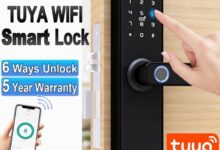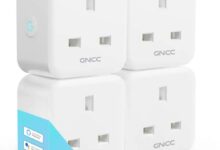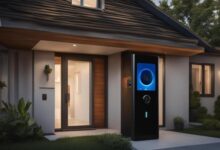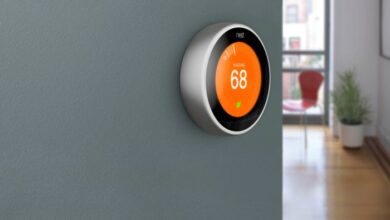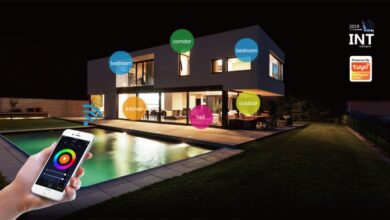Smart Home Devices A Comprehensive Guide
Smart Home Devices are transforming how we live, offering convenience, comfort, and enhanced security. From voice-activated assistants to self-learning thermostats, the possibilities seem endless. This guide delves into the fascinating world of smart home technology, exploring everything from the diverse range of available devices and their interoperability challenges to crucial security considerations and the exciting future of this rapidly evolving field.
We’ll unravel the complexities, highlighting both the benefits and potential pitfalls, to empower you to make informed decisions about integrating smart technology into your own home.
We’ll examine different device categories, comparing wired and wireless options, and exploring the leading smart home platforms like Google Home, Amazon Alexa, and Apple HomeKit. Understanding the nuances of interoperability is crucial for building a truly integrated and efficient smart home ecosystem. We’ll also address the vital concerns surrounding data security and privacy, offering practical tips and best practices to protect your home and personal information.
Finally, we’ll look ahead to the future, imagining the potential of artificial intelligence and the Internet of Things (IoT) in shaping the next generation of smart homes.
Types of Smart Home Devices
The smart home revolution is transforming how we live, offering convenience, efficiency, and enhanced security. Understanding the different types of smart home devices available is crucial for maximizing their potential and building a truly integrated system. This exploration will categorize various devices, examining their functionalities, and comparing wired and wireless options. A strategic approach to smart home integration requires careful consideration of these factors.
Categorization of Smart Home Devices
Smart home devices can be broadly categorized to better understand their individual roles within a cohesive system. The following table provides a snapshot of common device types, brand examples, typical features, and price ranges. Note that prices are approximate and can vary based on specific models and features.
| Device Type | Brand Example | Common Features | Typical Price Range (USD) |
|---|---|---|---|
| Smart Speakers | Amazon Echo, Google Home | Voice control, music playback, smart home control, information retrieval | $30 – $300 |
| Smart Lighting | Philips Hue, LIFX | Remote control, color customization, scheduling, integration with other smart home systems | $20 – $100 per bulb |
| Smart Thermostats | Nest, Ecobee | Programmable temperature control, energy efficiency features, remote monitoring | $150 – $300 |
| Smart Security Systems | Ring, SimpliSafe | Cameras, motion sensors, door/window sensors, remote monitoring, alarm system | $100 – $500+ (depending on system size and features) |
| Smart Locks | August, Schlage | Keyless entry, remote locking/unlocking, access codes, integration with other smart home systems | $150 – $300 |
| Smart Appliances | Samsung SmartThings, LG ThinQ | Remote control, scheduling, monitoring, energy efficiency features | Varies greatly depending on appliance |
Functionalities of Major Smart Home Device Categories
Smart speakers act as central hubs, controlling other devices through voice commands. Smart lighting offers personalized ambiance and energy savings through customizable schedules and automation. Smart thermostats learn user preferences to optimize energy consumption, resulting in lower utility bills. Smart security systems enhance home safety with real-time monitoring and alerts. Smart locks improve convenience and security by eliminating the need for traditional keys.
Finally, smart appliances streamline household tasks through remote control and automation. The integration of these devices creates a seamless and efficient smart home ecosystem.
Wired vs. Wireless Smart Home Devices
The choice between wired and wireless devices often depends on specific needs and installation complexities. Wired devices, such as some smart security systems components, offer greater reliability and security due to their direct connection, minimizing interference and potential hacking vulnerabilities. However, installation can be more complex and less flexible. Wireless devices, including most smart speakers and smart bulbs, are easier to install and offer greater flexibility in placement.
They are susceptible to interference and require reliable Wi-Fi or other wireless networks for operation. A hybrid approach, combining both wired and wireless devices, is often the optimal solution for achieving a robust and versatile smart home setup. For example, a wired security system backbone with wireless smart lighting offers both reliability and flexibility.
Smart Home Device Interoperability
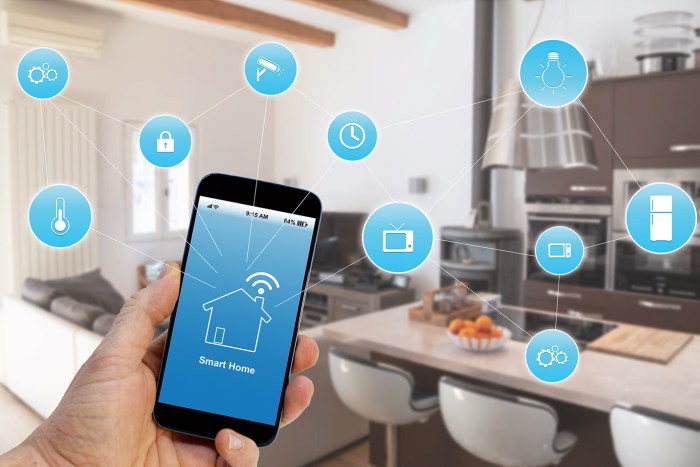
The dream of a truly seamless smart home, where all devices work together effortlessly, is hampered by a significant hurdle: interoperability. Different manufacturers often utilize proprietary protocols and platforms, creating frustrating incompatibility issues for consumers. This lack of universal standards hinders the full potential of smart home technology, leaving users grappling with fragmented ecosystems instead of enjoying a unified, intuitive experience.
Understanding the challenges and solutions related to smart home device interoperability is crucial for both consumers and the industry.
Challenges of Smart Home Ecosystem Interoperability
Achieving seamless communication between smart devices from various manufacturers presents several complex challenges. One major obstacle is the lack of standardized communication protocols. Each platform—be it Google Home, Amazon Alexa, Apple HomeKit, or others—often uses its own unique language, making it difficult for devices from different ecosystems to understand and interact with each other. Furthermore, security concerns are paramount.
Ensuring that the communication between disparate devices remains secure and prevents unauthorized access is a significant technical undertaking. Finally, the sheer number of devices and platforms on the market makes developing and implementing universal compatibility solutions a monumental task, requiring extensive collaboration across the industry. This complexity often leads to limitations in device functionality and integration.
Comparison of Popular Smart Home Platforms
A clear understanding of the strengths and weaknesses of different platforms is essential for making informed purchasing decisions. The following comparison highlights key differences between three prominent players:
- Google Home: Offers a wide range of device compatibility, strong voice control capabilities, and seamless integration with other Google services. However, its strength in home automation may be less comprehensive than others in certain areas.
- Amazon Alexa: Boasts a massive library of skills and integrations, making it highly versatile and adaptable to a wide range of smart home devices. Its voice recognition is generally considered reliable, but its focus on shopping and entertainment might overshadow home automation features for some users.
- Apple HomeKit: Prioritizes security and privacy, offering a tightly controlled ecosystem with robust encryption. However, this often results in limited compatibility with third-party devices compared to other platforms. Its ease of use is a strong point for Apple users.
Examples of Multi-Platform Compatible Smart Home Devices
While many devices are tied to a specific ecosystem, a growing number of manufacturers are designing devices compatible with multiple platforms. For instance, some smart bulbs offer compatibility with both Google Home and Amazon Alexa, allowing users to control them through their preferred voice assistant. Similarly, several smart plugs and switches are designed to work across various platforms, providing flexibility and choice.
This trend towards multi-platform compatibility is a positive step toward a more interconnected and user-friendly smart home experience. The increasing demand for such devices is pushing manufacturers to adopt more open standards.
Hypothetical Smart Home Setup with Seamless Interoperability
Imagine a home where a user wakes up to Philips Hue smart lights gradually brightening, controlled through Google Home. The Nest thermostat automatically adjusts the temperature based on occupancy detected by a compatible smart sensor. Meanwhile, a coffee maker, compatible with both Google Home and Alexa, starts brewing coffee, all orchestrated through a central smart hub. Later, the user uses an Apple HomeKit-enabled security system to arm the alarm before leaving, showcasing the potential for a truly integrated smart home environment.
This hypothetical scenario, while still aspirational in many aspects, underscores the value of interoperability and the benefits of a truly unified smart home experience. Such a scenario would require standardization and open protocols that are still under development.
Security and Privacy Concerns
The increasing integration of smart home devices offers unparalleled convenience, but this interconnectedness introduces significant security and privacy vulnerabilities. Understanding these risks and implementing robust protective measures is crucial for safeguarding your home and personal data. Failing to do so can expose you to a range of threats, from minor inconveniences to serious financial and personal harm.
Potential Security Vulnerabilities
Smart home devices, while convenient, often present significant security risks. Many devices utilize default passwords or lack strong encryption, making them vulnerable to hacking. A compromised device can serve as an entry point for attackers to access your entire network, potentially stealing sensitive data or controlling other devices. This vulnerability is exacerbated by the fact that many users fail to update their devices’ firmware, leaving them susceptible to known exploits.
For instance, a poorly secured smart camera could be hijacked to spy on your home, while a compromised smart lock could grant unauthorized access. The lack of standardized security protocols across different brands further compounds the issue.
Securing Smart Home Networks and Devices
Implementing strong security practices is paramount to mitigating the risks associated with smart home devices. This starts with using strong, unique passwords for each device and regularly updating firmware to patch security vulnerabilities. Employing a robust firewall and intrusion detection system can help identify and block malicious activity. Consider segmenting your network, separating smart home devices from other sensitive devices like computers and laptops, to limit the impact of a potential breach.
Enabling two-factor authentication whenever possible adds an extra layer of security. Finally, choosing reputable brands known for their commitment to security is a crucial preventative measure. A layered approach, combining multiple security strategies, is the most effective way to protect your smart home.
Privacy Implications of Data Collection, Smart Home Devices
Smart home devices constantly collect data about your habits and preferences, raising significant privacy concerns. This data, which can include your location, daily routines, and even conversations, is often stored on servers controlled by the device manufacturers. While many manufacturers claim to anonymize this data, the potential for misuse remains. Data breaches can expose this information, leading to identity theft or other forms of privacy violations.
Furthermore, the potential for data aggregation and profiling raises ethical questions about the use of personal information. For example, aggregated data from multiple smart home devices could create a detailed profile of an individual’s lifestyle, potentially used for targeted advertising or even more nefarious purposes.
Best Practices for Maintaining Security and Privacy
Maintaining a secure and private smart home environment requires a proactive approach. A comprehensive checklist should include: using strong, unique passwords for each device; regularly updating firmware; enabling two-factor authentication where available; installing a robust firewall and intrusion detection system; segmenting your network; being mindful of the data collected by your devices and reviewing privacy policies; choosing reputable brands; and using a Virtual Private Network (VPN) for enhanced security and privacy.
Regularly reviewing your network’s security settings and keeping abreast of the latest security threats is also crucial. By implementing these best practices, you can significantly reduce the risk of security breaches and protect your privacy in your connected home.
Smart Home Device Installation and Setup: Smart Home Devices
Stepping into the world of smart home technology can feel daunting, but the process of installing and setting up most devices is surprisingly straightforward. This guide provides a practical, step-by-step approach, focusing on common devices and troubleshooting potential problems to ensure a smooth transition to a more automated home. Understanding the installation process is key to maximizing your smart home investment and enjoying its benefits.
Smart Light Bulb Installation and Setup
Installing a smart light bulb is a great starting point for anyone venturing into the smart home ecosystem. It’s a relatively simple process, requiring minimal technical expertise. The following steps illustrate a typical installation, using a common screw-in smart bulb as an example.
- Unscrew the existing bulb: Carefully remove the old light bulb from the fixture, ensuring you don’t touch the glass with your bare hands to avoid leaving fingerprints.
- Screw in the smart bulb: Gently screw the new smart bulb into the fixture, making sure it’s securely fastened.
- Download the app: Download the manufacturer’s app from your smartphone’s app store (Apple App Store or Google Play Store). Each brand has its own app, so ensure you download the correct one.
- Create an account: Create a user account within the app, following the on-screen instructions. You will typically need to provide an email address and password.
- Connect the bulb to Wi-Fi: The app will guide you through the process of connecting the smart bulb to your home’s Wi-Fi network. This usually involves selecting your network name (SSID) and entering your Wi-Fi password. Some bulbs use a unique QR code for faster pairing.
- Test the bulb: Once connected, test the bulb’s functionality through the app. You should be able to turn it on and off, adjust brightness, and potentially change the color temperature.
Troubleshooting Common Installation Issues
Even with straightforward installations, problems can arise. Addressing these proactively can prevent frustration and ensure a successful setup.
- Bulb not detected: If the app doesn’t detect the bulb, ensure it’s properly screwed in and your Wi-Fi network is working correctly. Restarting your router and the bulb (by switching it off and on) can often resolve this issue. Check for signal strength issues in your home.
- Weak or intermittent Wi-Fi signal: A weak or unstable Wi-Fi signal can prevent the bulb from connecting. Consider using a Wi-Fi extender or repositioning your router for better coverage. A mesh Wi-Fi system can be a good investment for larger homes.
- App connectivity problems: If the app is not connecting to the bulb or your network, try restarting the app, your phone, and your router. Check for app updates and ensure your phone’s internet connection is stable.
- Incorrect Wi-Fi password: Double-check that you have entered the correct Wi-Fi password. A simple typo can prevent successful connection.
Connecting Smart Home Devices to a Home Network
There are several ways to connect smart home devices to your home network. The most common methods include Wi-Fi, Bluetooth, and Zigbee/Z-Wave. Understanding these methods helps you choose the right devices for your setup.
Wi-Fi is the most common method, offering a wide range and ease of setup. Bluetooth typically has a shorter range and requires closer proximity to the main hub. Zigbee and Z-Wave are mesh networking protocols offering greater range and reliability, particularly useful for larger homes. They usually require a hub, which acts as a central controller for these devices.
Choosing the Right Smart Home Devices
Selecting the right smart home devices involves considering your needs, budget, and existing infrastructure. Prioritize devices that integrate seamlessly with your current technology and align with your desired level of automation.
Start with a few core devices that address your most pressing needs, such as smart lighting or a smart thermostat. Gradually expand your system as your budget allows and your experience grows. Research different brands and models to compare features, compatibility, and pricing. Reading online reviews can be invaluable in making informed decisions. For instance, a smart lighting system can offer significant energy savings over time, offsetting the initial investment.
Likewise, a smart thermostat can help optimize heating and cooling, reducing your energy bills.
The Future of Smart Home Technology
The smart home revolution is far from over. We’re on the cusp of a new era where homes become truly proactive, anticipating our needs and seamlessly integrating with our lives in ways we can barely imagine today. This evolution will be driven by advancements in artificial intelligence, the Internet of Things, and a growing emphasis on sustainability. The implications are profound, transforming not just how we live, but also how we interact with our environment and each other.
AI-Powered Predictive Capabilities
Artificial intelligence will be the driving force behind the next generation of smart homes. Imagine a home that learns your routines, anticipates your needs, and proactively adjusts settings to optimize comfort and efficiency. For instance, your smart thermostat might learn that you prefer a slightly cooler temperature in the mornings and automatically adjust accordingly, even before you wake up.
AI-powered systems will also improve security, detecting anomalies and alerting you to potential threats in real-time, going beyond simple motion detection to analyze patterns and behaviors. This predictive capability extends to energy management, optimizing energy consumption based on predicted occupancy and weather patterns, leading to significant cost savings. Consider the potential for AI to automatically adjust lighting based on natural light availability, further minimizing energy waste.
The Expansion of IoT Ecosystem
The Internet of Things (IoT) will continue its exponential growth within the smart home landscape. We’ll see an increasing number of everyday objects connected to the network, from appliances and furniture to clothing and personal care items. This interconnectedness will lead to a more holistic and personalized experience. Imagine a refrigerator that automatically reorders groceries when supplies are low, or a washing machine that alerts you when it needs maintenance.
The integration of various smart devices will create seamless automation, enabling complex scenarios, such as automatically dimming the lights and playing calming music when you enter relaxation mode. Companies like Amazon and Google are already expanding their ecosystems, paving the way for a more integrated and user-friendly experience. The challenge will be to ensure seamless interoperability between devices from different manufacturers.
Sustainability and Energy Efficiency
Smart homes are poised to play a critical role in achieving global sustainability goals. By intelligently managing energy consumption, these systems can significantly reduce a household’s carbon footprint. Smart thermostats, for example, already help to optimize heating and cooling, while smart lighting systems can adjust brightness based on ambient light and occupancy. Future advancements will further enhance energy efficiency through features like intelligent grid integration, allowing homes to participate in demand response programs and optimize energy use based on real-time grid conditions.
This will not only reduce energy costs but also contribute to a more stable and sustainable energy grid. Examples of this already exist in pilot programs across several countries where smart homes are being integrated into microgrids, creating resilient and environmentally friendly energy systems.
A Futuristic Smart Home Vision
Imagine a home seamlessly integrated with its environment. The exterior walls are covered with dynamic solar panels, adapting their angle to maximize energy capture. The interior is bathed in natural light, augmented by intelligent lighting systems that adjust color temperature and intensity based on time of day and occupant preferences. The home anticipates your needs; the coffee maker starts brewing before you even wake up, and the smart thermostat adjusts the temperature to your ideal comfort level.
Security is integrated and invisible: advanced sensors monitor the perimeter, detecting potential threats before they even reach the house. The home’s systems are interconnected, learning your habits and preferences, making life simpler, more efficient, and more enjoyable. This home is not just a dwelling; it’s a responsive, adaptive ecosystem, designed to support your well-being and contribute to a sustainable future.
Final Thoughts
The journey into the world of smart home devices is an exciting one, filled with innovation and the potential to dramatically improve our daily lives. While challenges remain, particularly regarding interoperability and security, the advancements in technology and the growing awareness of potential risks are paving the way for a more seamless and secure smart home experience. By understanding the various device types, platforms, and security protocols, you can harness the power of smart technology to create a home that’s not only convenient and comfortable but also safe and efficient.
The future of the smart home is bright, and this guide has equipped you with the knowledge to navigate it confidently.
